Generalized Anxiety Disorder Answer 2022
VerifiedAdded on 2022/09/16
|12
|2628
|27
AI Summary
Contribute Materials
Your contribution can guide someone’s learning journey. Share your
documents today.

Running Head: GAD
0
GAD
student
8/29/2019
0
GAD
student
8/29/2019
Secure Best Marks with AI Grader
Need help grading? Try our AI Grader for instant feedback on your assignments.
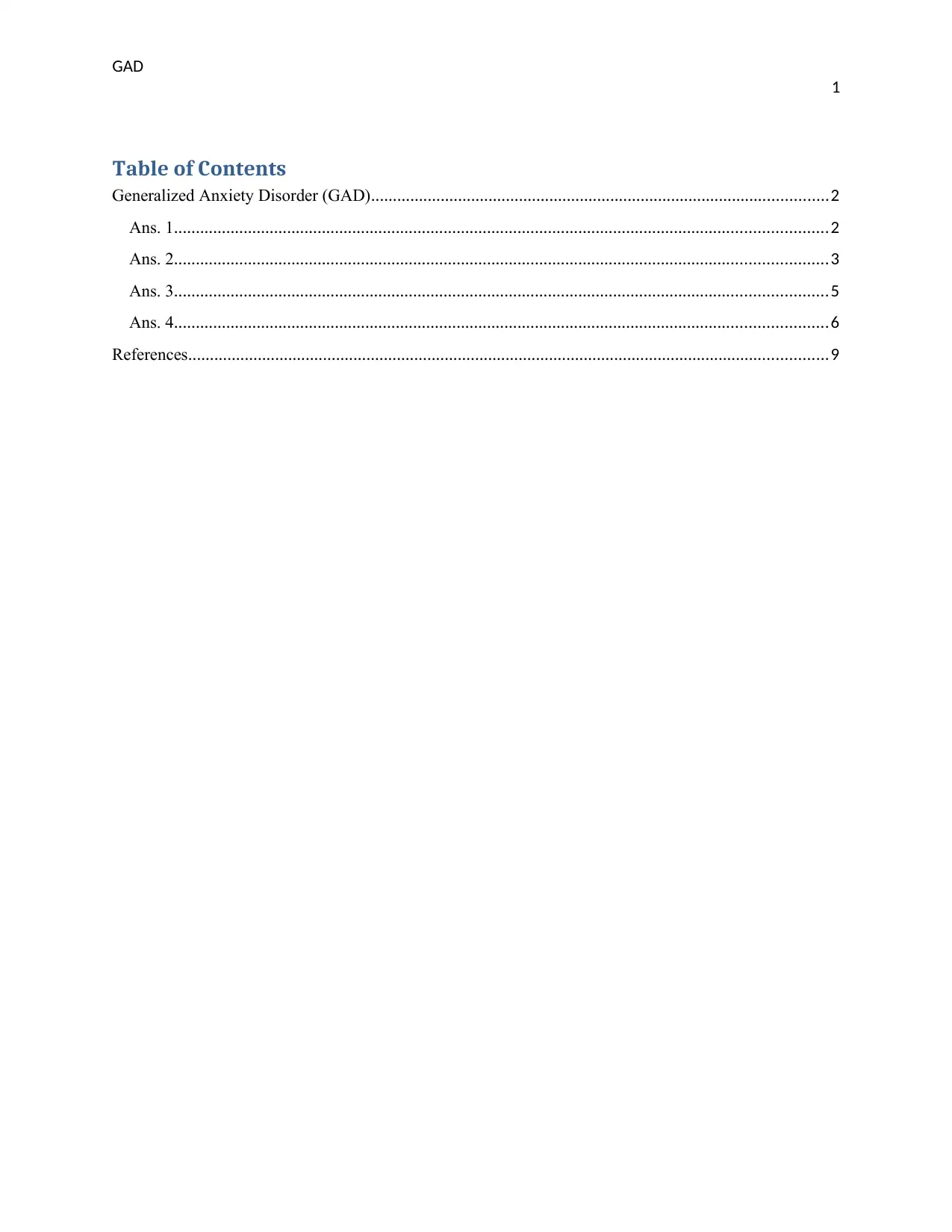
GAD
1
Table of Contents
Generalized Anxiety Disorder (GAD).........................................................................................................2
Ans. 1......................................................................................................................................................2
Ans. 2......................................................................................................................................................3
Ans. 3......................................................................................................................................................5
Ans. 4......................................................................................................................................................6
References...................................................................................................................................................9
1
Table of Contents
Generalized Anxiety Disorder (GAD).........................................................................................................2
Ans. 1......................................................................................................................................................2
Ans. 2......................................................................................................................................................3
Ans. 3......................................................................................................................................................5
Ans. 4......................................................................................................................................................6
References...................................................................................................................................................9
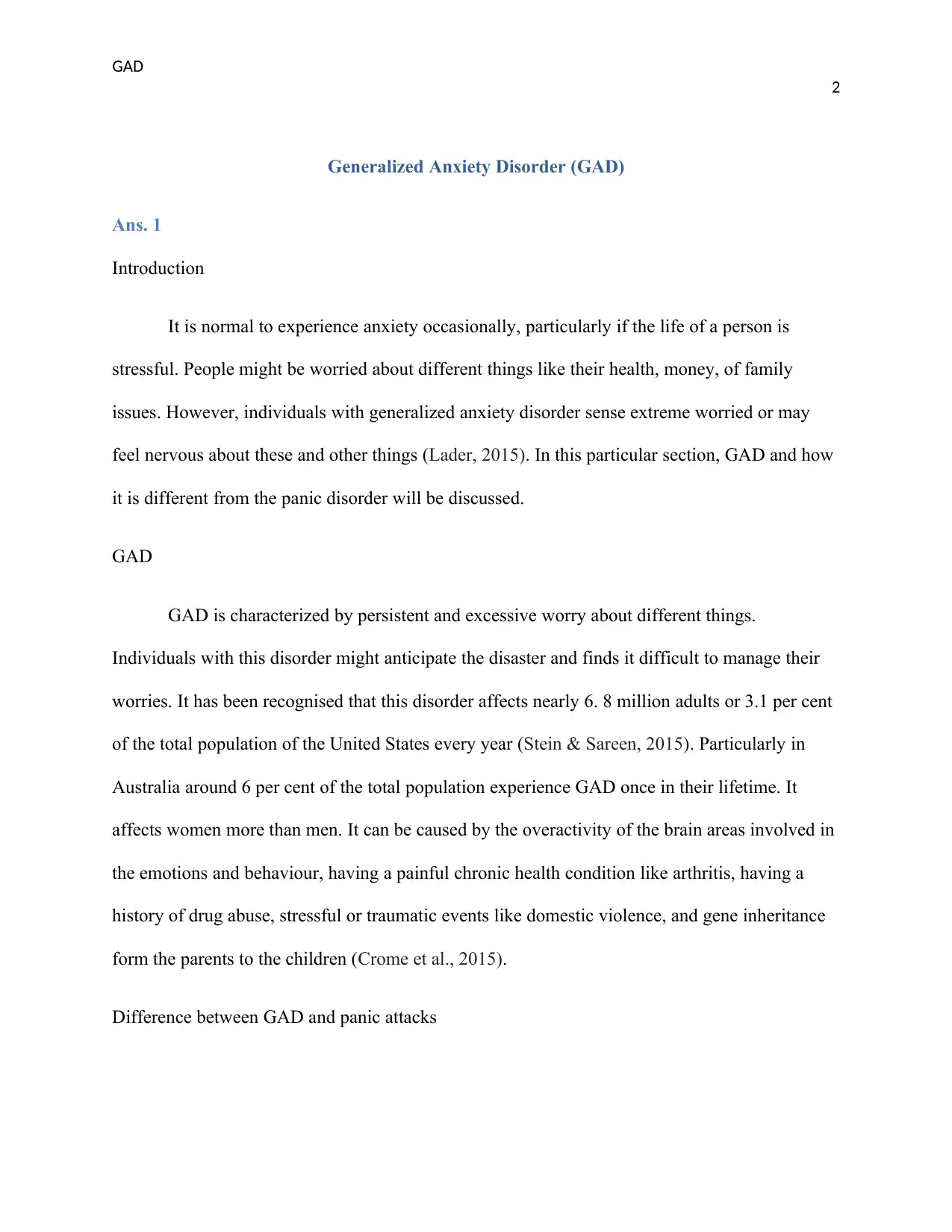
GAD
2
Generalized Anxiety Disorder (GAD)
Ans. 1
Introduction
It is normal to experience anxiety occasionally, particularly if the life of a person is
stressful. People might be worried about different things like their health, money, of family
issues. However, individuals with generalized anxiety disorder sense extreme worried or may
feel nervous about these and other things (Lader, 2015). In this particular section, GAD and how
it is different from the panic disorder will be discussed.
GAD
GAD is characterized by persistent and excessive worry about different things.
Individuals with this disorder might anticipate the disaster and finds it difficult to manage their
worries. It has been recognised that this disorder affects nearly 6. 8 million adults or 3.1 per cent
of the total population of the United States every year (Stein & Sareen, 2015). Particularly in
Australia around 6 per cent of the total population experience GAD once in their lifetime. It
affects women more than men. It can be caused by the overactivity of the brain areas involved in
the emotions and behaviour, having a painful chronic health condition like arthritis, having a
history of drug abuse, stressful or traumatic events like domestic violence, and gene inheritance
form the parents to the children (Crome et al., 2015).
Difference between GAD and panic attacks
2
Generalized Anxiety Disorder (GAD)
Ans. 1
Introduction
It is normal to experience anxiety occasionally, particularly if the life of a person is
stressful. People might be worried about different things like their health, money, of family
issues. However, individuals with generalized anxiety disorder sense extreme worried or may
feel nervous about these and other things (Lader, 2015). In this particular section, GAD and how
it is different from the panic disorder will be discussed.
GAD
GAD is characterized by persistent and excessive worry about different things.
Individuals with this disorder might anticipate the disaster and finds it difficult to manage their
worries. It has been recognised that this disorder affects nearly 6. 8 million adults or 3.1 per cent
of the total population of the United States every year (Stein & Sareen, 2015). Particularly in
Australia around 6 per cent of the total population experience GAD once in their lifetime. It
affects women more than men. It can be caused by the overactivity of the brain areas involved in
the emotions and behaviour, having a painful chronic health condition like arthritis, having a
history of drug abuse, stressful or traumatic events like domestic violence, and gene inheritance
form the parents to the children (Crome et al., 2015).
Difference between GAD and panic attacks
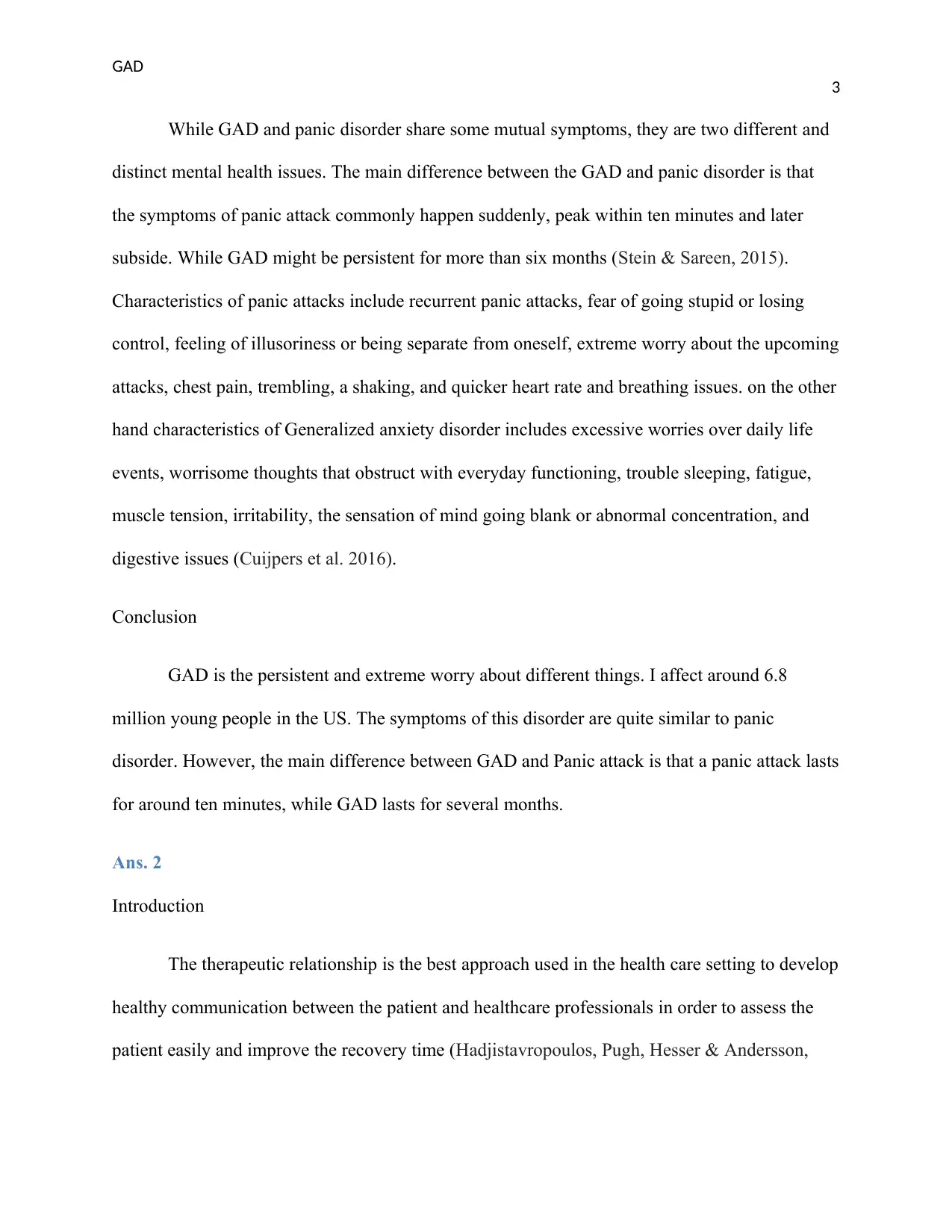
GAD
3
While GAD and panic disorder share some mutual symptoms, they are two different and
distinct mental health issues. The main difference between the GAD and panic disorder is that
the symptoms of panic attack commonly happen suddenly, peak within ten minutes and later
subside. While GAD might be persistent for more than six months (Stein & Sareen, 2015).
Characteristics of panic attacks include recurrent panic attacks, fear of going stupid or losing
control, feeling of illusoriness or being separate from oneself, extreme worry about the upcoming
attacks, chest pain, trembling, a shaking, and quicker heart rate and breathing issues. on the other
hand characteristics of Generalized anxiety disorder includes excessive worries over daily life
events, worrisome thoughts that obstruct with everyday functioning, trouble sleeping, fatigue,
muscle tension, irritability, the sensation of mind going blank or abnormal concentration, and
digestive issues (Cuijpers et al. 2016).
Conclusion
GAD is the persistent and extreme worry about different things. I affect around 6.8
million young people in the US. The symptoms of this disorder are quite similar to panic
disorder. However, the main difference between GAD and Panic attack is that a panic attack lasts
for around ten minutes, while GAD lasts for several months.
Ans. 2
Introduction
The therapeutic relationship is the best approach used in the health care setting to develop
healthy communication between the patient and healthcare professionals in order to assess the
patient easily and improve the recovery time (Hadjistavropoulos, Pugh, Hesser & Andersson,
3
While GAD and panic disorder share some mutual symptoms, they are two different and
distinct mental health issues. The main difference between the GAD and panic disorder is that
the symptoms of panic attack commonly happen suddenly, peak within ten minutes and later
subside. While GAD might be persistent for more than six months (Stein & Sareen, 2015).
Characteristics of panic attacks include recurrent panic attacks, fear of going stupid or losing
control, feeling of illusoriness or being separate from oneself, extreme worry about the upcoming
attacks, chest pain, trembling, a shaking, and quicker heart rate and breathing issues. on the other
hand characteristics of Generalized anxiety disorder includes excessive worries over daily life
events, worrisome thoughts that obstruct with everyday functioning, trouble sleeping, fatigue,
muscle tension, irritability, the sensation of mind going blank or abnormal concentration, and
digestive issues (Cuijpers et al. 2016).
Conclusion
GAD is the persistent and extreme worry about different things. I affect around 6.8
million young people in the US. The symptoms of this disorder are quite similar to panic
disorder. However, the main difference between GAD and Panic attack is that a panic attack lasts
for around ten minutes, while GAD lasts for several months.
Ans. 2
Introduction
The therapeutic relationship is the best approach used in the health care setting to develop
healthy communication between the patient and healthcare professionals in order to assess the
patient easily and improve the recovery time (Hadjistavropoulos, Pugh, Hesser & Andersson,
Secure Best Marks with AI Grader
Need help grading? Try our AI Grader for instant feedback on your assignments.
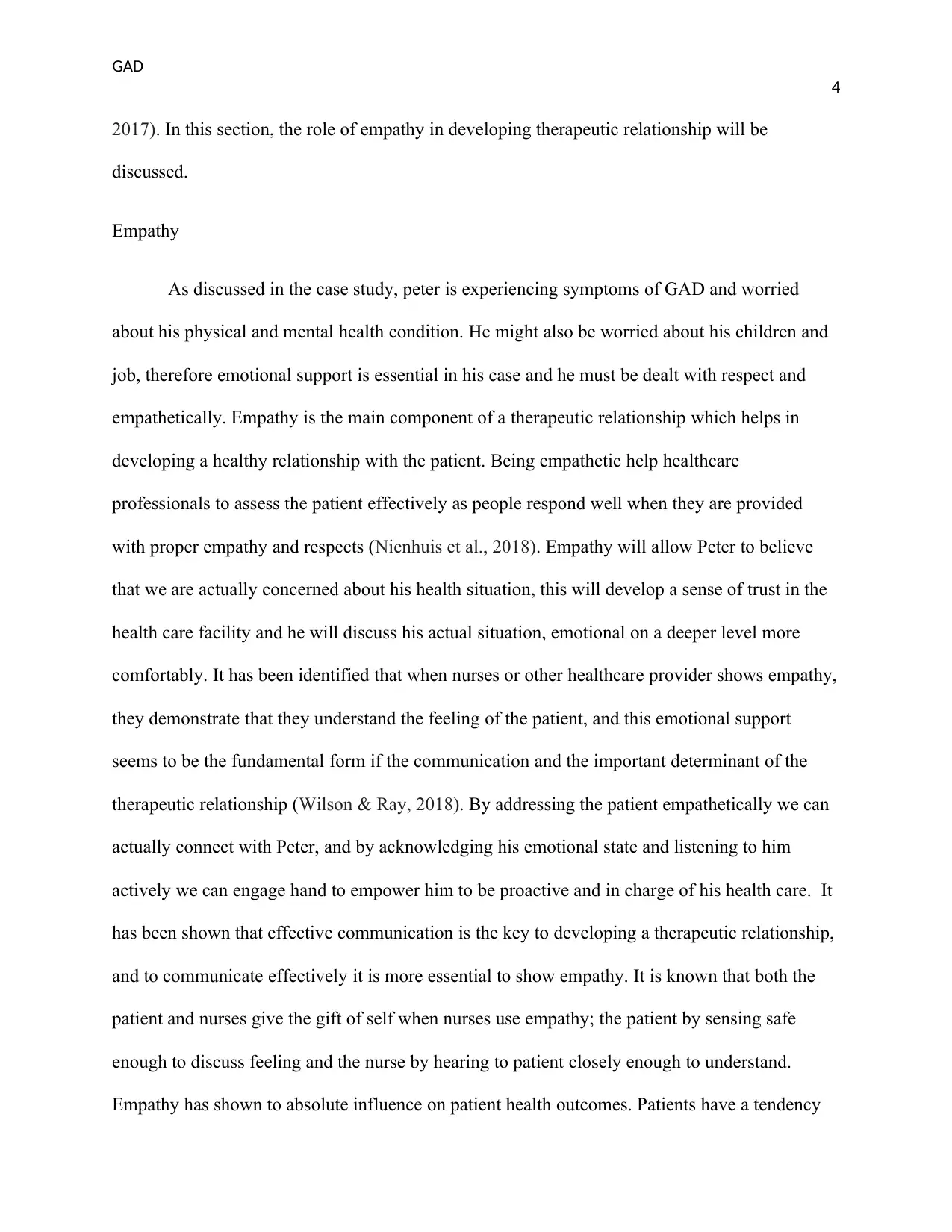
GAD
4
2017). In this section, the role of empathy in developing therapeutic relationship will be
discussed.
Empathy
As discussed in the case study, peter is experiencing symptoms of GAD and worried
about his physical and mental health condition. He might also be worried about his children and
job, therefore emotional support is essential in his case and he must be dealt with respect and
empathetically. Empathy is the main component of a therapeutic relationship which helps in
developing a healthy relationship with the patient. Being empathetic help healthcare
professionals to assess the patient effectively as people respond well when they are provided
with proper empathy and respects (Nienhuis et al., 2018). Empathy will allow Peter to believe
that we are actually concerned about his health situation, this will develop a sense of trust in the
health care facility and he will discuss his actual situation, emotional on a deeper level more
comfortably. It has been identified that when nurses or other healthcare provider shows empathy,
they demonstrate that they understand the feeling of the patient, and this emotional support
seems to be the fundamental form if the communication and the important determinant of the
therapeutic relationship (Wilson & Ray, 2018). By addressing the patient empathetically we can
actually connect with Peter, and by acknowledging his emotional state and listening to him
actively we can engage hand to empower him to be proactive and in charge of his health care. It
has been shown that effective communication is the key to developing a therapeutic relationship,
and to communicate effectively it is more essential to show empathy. It is known that both the
patient and nurses give the gift of self when nurses use empathy; the patient by sensing safe
enough to discuss feeling and the nurse by hearing to patient closely enough to understand.
Empathy has shown to absolute influence on patient health outcomes. Patients have a tendency
4
2017). In this section, the role of empathy in developing therapeutic relationship will be
discussed.
Empathy
As discussed in the case study, peter is experiencing symptoms of GAD and worried
about his physical and mental health condition. He might also be worried about his children and
job, therefore emotional support is essential in his case and he must be dealt with respect and
empathetically. Empathy is the main component of a therapeutic relationship which helps in
developing a healthy relationship with the patient. Being empathetic help healthcare
professionals to assess the patient effectively as people respond well when they are provided
with proper empathy and respects (Nienhuis et al., 2018). Empathy will allow Peter to believe
that we are actually concerned about his health situation, this will develop a sense of trust in the
health care facility and he will discuss his actual situation, emotional on a deeper level more
comfortably. It has been identified that when nurses or other healthcare provider shows empathy,
they demonstrate that they understand the feeling of the patient, and this emotional support
seems to be the fundamental form if the communication and the important determinant of the
therapeutic relationship (Wilson & Ray, 2018). By addressing the patient empathetically we can
actually connect with Peter, and by acknowledging his emotional state and listening to him
actively we can engage hand to empower him to be proactive and in charge of his health care. It
has been shown that effective communication is the key to developing a therapeutic relationship,
and to communicate effectively it is more essential to show empathy. It is known that both the
patient and nurses give the gift of self when nurses use empathy; the patient by sensing safe
enough to discuss feeling and the nurse by hearing to patient closely enough to understand.
Empathy has shown to absolute influence on patient health outcomes. Patients have a tendency
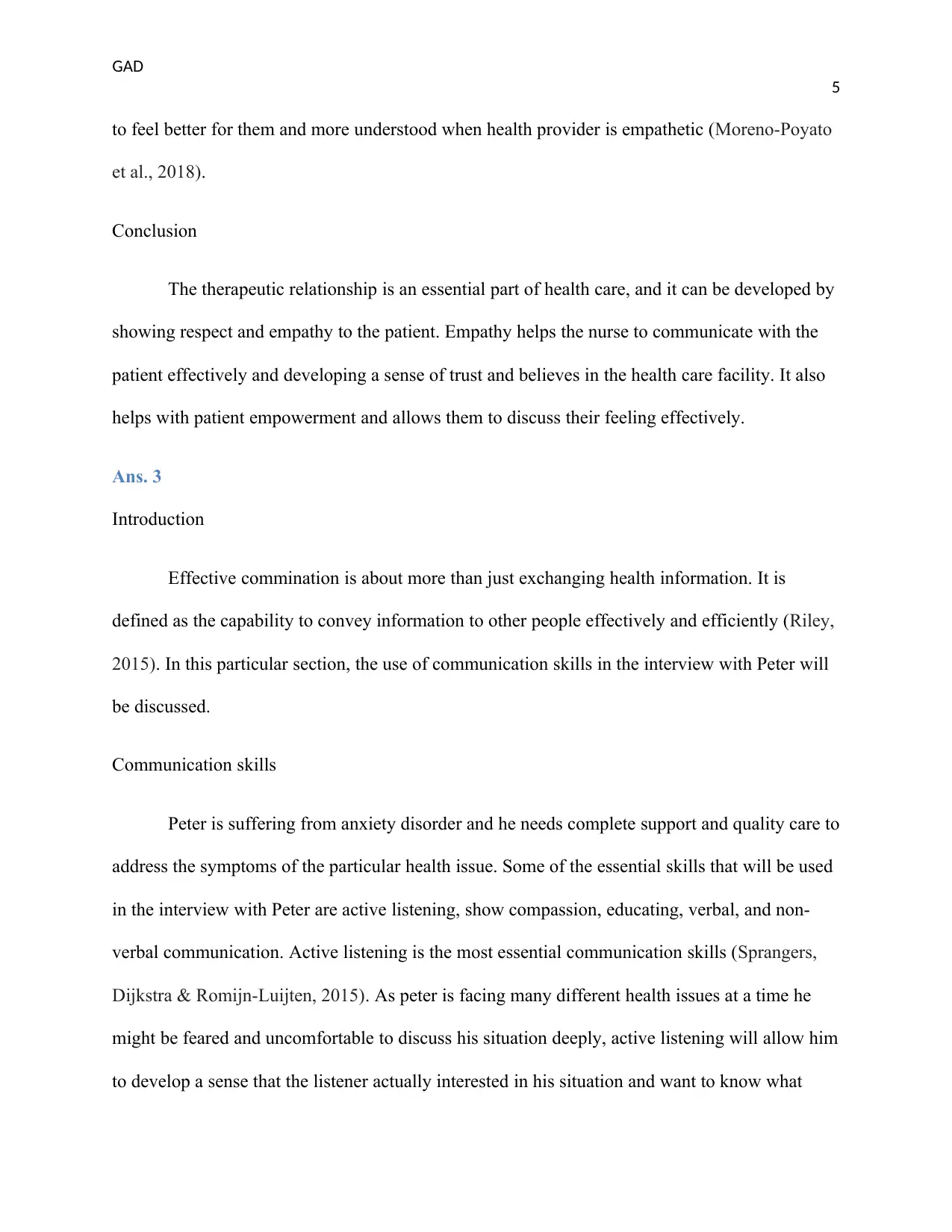
GAD
5
to feel better for them and more understood when health provider is empathetic (Moreno-Poyato
et al., 2018).
Conclusion
The therapeutic relationship is an essential part of health care, and it can be developed by
showing respect and empathy to the patient. Empathy helps the nurse to communicate with the
patient effectively and developing a sense of trust and believes in the health care facility. It also
helps with patient empowerment and allows them to discuss their feeling effectively.
Ans. 3
Introduction
Effective commination is about more than just exchanging health information. It is
defined as the capability to convey information to other people effectively and efficiently (Riley,
2015). In this particular section, the use of communication skills in the interview with Peter will
be discussed.
Communication skills
Peter is suffering from anxiety disorder and he needs complete support and quality care to
address the symptoms of the particular health issue. Some of the essential skills that will be used
in the interview with Peter are active listening, show compassion, educating, verbal, and non-
verbal communication. Active listening is the most essential communication skills (Sprangers,
Dijkstra & Romijn-Luijten, 2015). As peter is facing many different health issues at a time he
might be feared and uncomfortable to discuss his situation deeply, active listening will allow him
to develop a sense that the listener actually interested in his situation and want to know what
5
to feel better for them and more understood when health provider is empathetic (Moreno-Poyato
et al., 2018).
Conclusion
The therapeutic relationship is an essential part of health care, and it can be developed by
showing respect and empathy to the patient. Empathy helps the nurse to communicate with the
patient effectively and developing a sense of trust and believes in the health care facility. It also
helps with patient empowerment and allows them to discuss their feeling effectively.
Ans. 3
Introduction
Effective commination is about more than just exchanging health information. It is
defined as the capability to convey information to other people effectively and efficiently (Riley,
2015). In this particular section, the use of communication skills in the interview with Peter will
be discussed.
Communication skills
Peter is suffering from anxiety disorder and he needs complete support and quality care to
address the symptoms of the particular health issue. Some of the essential skills that will be used
in the interview with Peter are active listening, show compassion, educating, verbal, and non-
verbal communication. Active listening is the most essential communication skills (Sprangers,
Dijkstra & Romijn-Luijten, 2015). As peter is facing many different health issues at a time he
might be feared and uncomfortable to discuss his situation deeply, active listening will allow him
to develop a sense that the listener actually interested in his situation and want to know what
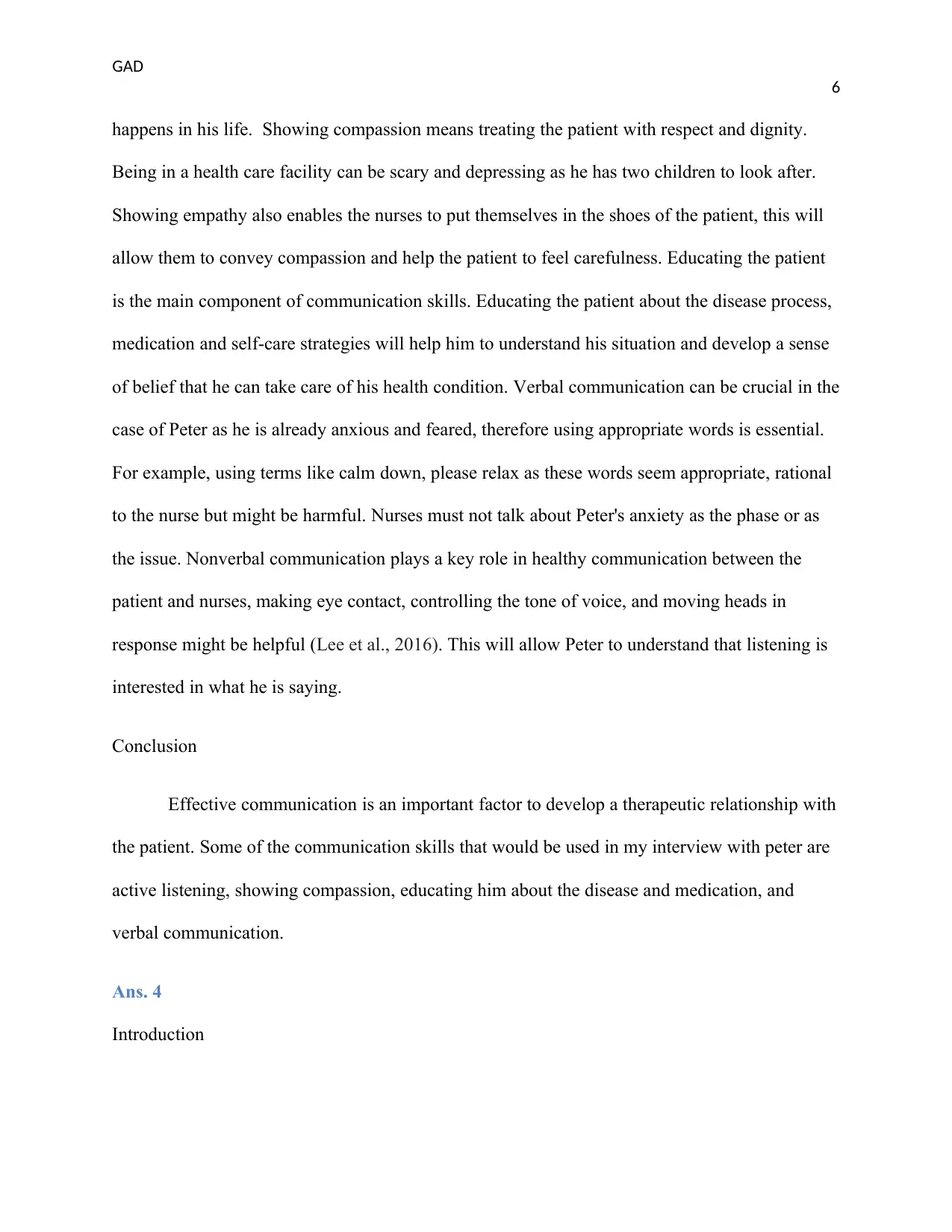
GAD
6
happens in his life. Showing compassion means treating the patient with respect and dignity.
Being in a health care facility can be scary and depressing as he has two children to look after.
Showing empathy also enables the nurses to put themselves in the shoes of the patient, this will
allow them to convey compassion and help the patient to feel carefulness. Educating the patient
is the main component of communication skills. Educating the patient about the disease process,
medication and self-care strategies will help him to understand his situation and develop a sense
of belief that he can take care of his health condition. Verbal communication can be crucial in the
case of Peter as he is already anxious and feared, therefore using appropriate words is essential.
For example, using terms like calm down, please relax as these words seem appropriate, rational
to the nurse but might be harmful. Nurses must not talk about Peter's anxiety as the phase or as
the issue. Nonverbal communication plays a key role in healthy communication between the
patient and nurses, making eye contact, controlling the tone of voice, and moving heads in
response might be helpful (Lee et al., 2016). This will allow Peter to understand that listening is
interested in what he is saying.
Conclusion
Effective communication is an important factor to develop a therapeutic relationship with
the patient. Some of the communication skills that would be used in my interview with peter are
active listening, showing compassion, educating him about the disease and medication, and
verbal communication.
Ans. 4
Introduction
6
happens in his life. Showing compassion means treating the patient with respect and dignity.
Being in a health care facility can be scary and depressing as he has two children to look after.
Showing empathy also enables the nurses to put themselves in the shoes of the patient, this will
allow them to convey compassion and help the patient to feel carefulness. Educating the patient
is the main component of communication skills. Educating the patient about the disease process,
medication and self-care strategies will help him to understand his situation and develop a sense
of belief that he can take care of his health condition. Verbal communication can be crucial in the
case of Peter as he is already anxious and feared, therefore using appropriate words is essential.
For example, using terms like calm down, please relax as these words seem appropriate, rational
to the nurse but might be harmful. Nurses must not talk about Peter's anxiety as the phase or as
the issue. Nonverbal communication plays a key role in healthy communication between the
patient and nurses, making eye contact, controlling the tone of voice, and moving heads in
response might be helpful (Lee et al., 2016). This will allow Peter to understand that listening is
interested in what he is saying.
Conclusion
Effective communication is an important factor to develop a therapeutic relationship with
the patient. Some of the communication skills that would be used in my interview with peter are
active listening, showing compassion, educating him about the disease and medication, and
verbal communication.
Ans. 4
Introduction
Paraphrase This Document
Need a fresh take? Get an instant paraphrase of this document with our AI Paraphraser
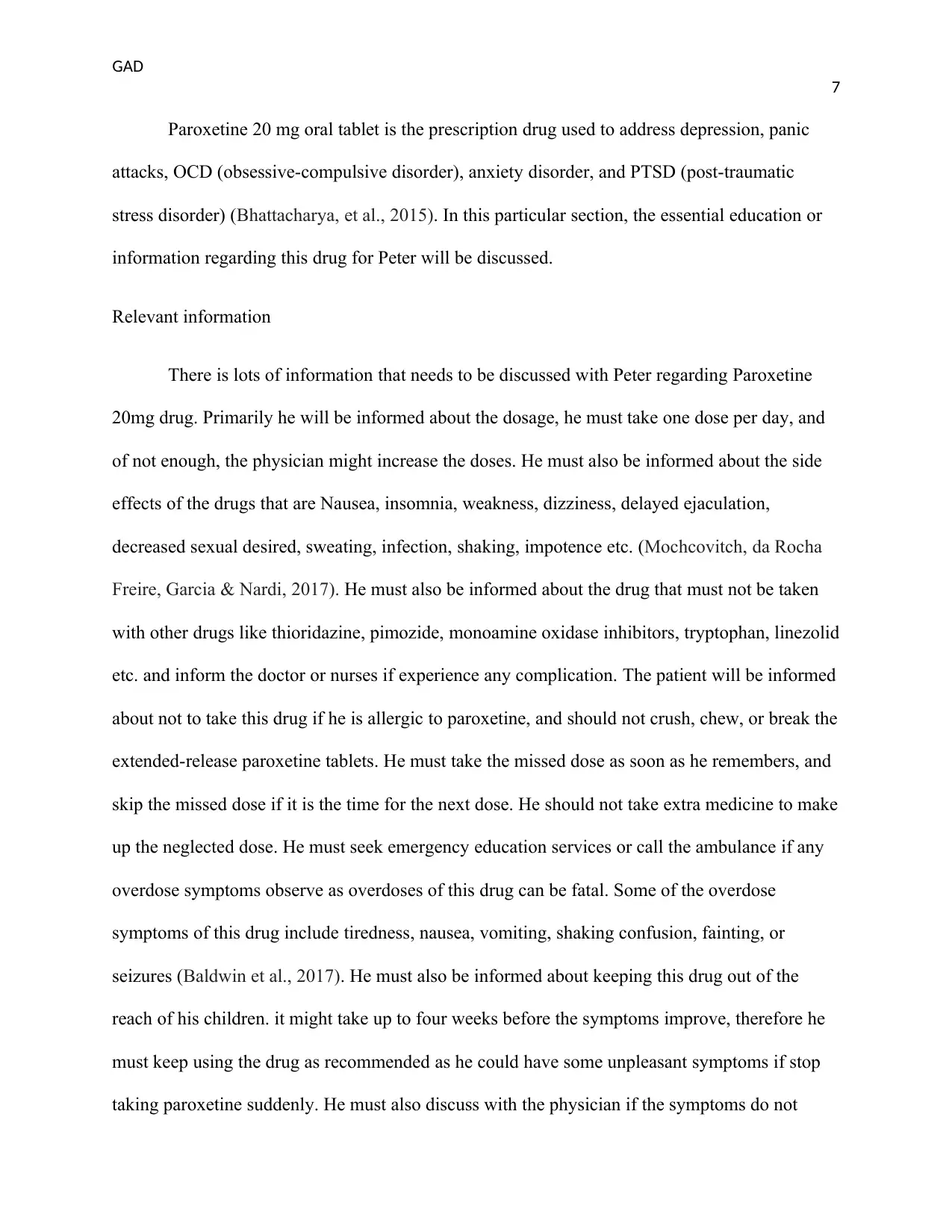
GAD
7
Paroxetine 20 mg oral tablet is the prescription drug used to address depression, panic
attacks, OCD (obsessive-compulsive disorder), anxiety disorder, and PTSD (post-traumatic
stress disorder) (Bhattacharya, et al., 2015). In this particular section, the essential education or
information regarding this drug for Peter will be discussed.
Relevant information
There is lots of information that needs to be discussed with Peter regarding Paroxetine
20mg drug. Primarily he will be informed about the dosage, he must take one dose per day, and
of not enough, the physician might increase the doses. He must also be informed about the side
effects of the drugs that are Nausea, insomnia, weakness, dizziness, delayed ejaculation,
decreased sexual desired, sweating, infection, shaking, impotence etc. (Mochcovitch, da Rocha
Freire, Garcia & Nardi, 2017). He must also be informed about the drug that must not be taken
with other drugs like thioridazine, pimozide, monoamine oxidase inhibitors, tryptophan, linezolid
etc. and inform the doctor or nurses if experience any complication. The patient will be informed
about not to take this drug if he is allergic to paroxetine, and should not crush, chew, or break the
extended-release paroxetine tablets. He must take the missed dose as soon as he remembers, and
skip the missed dose if it is the time for the next dose. He should not take extra medicine to make
up the neglected dose. He must seek emergency education services or call the ambulance if any
overdose symptoms observe as overdoses of this drug can be fatal. Some of the overdose
symptoms of this drug include tiredness, nausea, vomiting, shaking confusion, fainting, or
seizures (Baldwin et al., 2017). He must also be informed about keeping this drug out of the
reach of his children. it might take up to four weeks before the symptoms improve, therefore he
must keep using the drug as recommended as he could have some unpleasant symptoms if stop
taking paroxetine suddenly. He must also discuss with the physician if the symptoms do not
7
Paroxetine 20 mg oral tablet is the prescription drug used to address depression, panic
attacks, OCD (obsessive-compulsive disorder), anxiety disorder, and PTSD (post-traumatic
stress disorder) (Bhattacharya, et al., 2015). In this particular section, the essential education or
information regarding this drug for Peter will be discussed.
Relevant information
There is lots of information that needs to be discussed with Peter regarding Paroxetine
20mg drug. Primarily he will be informed about the dosage, he must take one dose per day, and
of not enough, the physician might increase the doses. He must also be informed about the side
effects of the drugs that are Nausea, insomnia, weakness, dizziness, delayed ejaculation,
decreased sexual desired, sweating, infection, shaking, impotence etc. (Mochcovitch, da Rocha
Freire, Garcia & Nardi, 2017). He must also be informed about the drug that must not be taken
with other drugs like thioridazine, pimozide, monoamine oxidase inhibitors, tryptophan, linezolid
etc. and inform the doctor or nurses if experience any complication. The patient will be informed
about not to take this drug if he is allergic to paroxetine, and should not crush, chew, or break the
extended-release paroxetine tablets. He must take the missed dose as soon as he remembers, and
skip the missed dose if it is the time for the next dose. He should not take extra medicine to make
up the neglected dose. He must seek emergency education services or call the ambulance if any
overdose symptoms observe as overdoses of this drug can be fatal. Some of the overdose
symptoms of this drug include tiredness, nausea, vomiting, shaking confusion, fainting, or
seizures (Baldwin et al., 2017). He must also be informed about keeping this drug out of the
reach of his children. it might take up to four weeks before the symptoms improve, therefore he
must keep using the drug as recommended as he could have some unpleasant symptoms if stop
taking paroxetine suddenly. He must also discuss with the physician if the symptoms do not
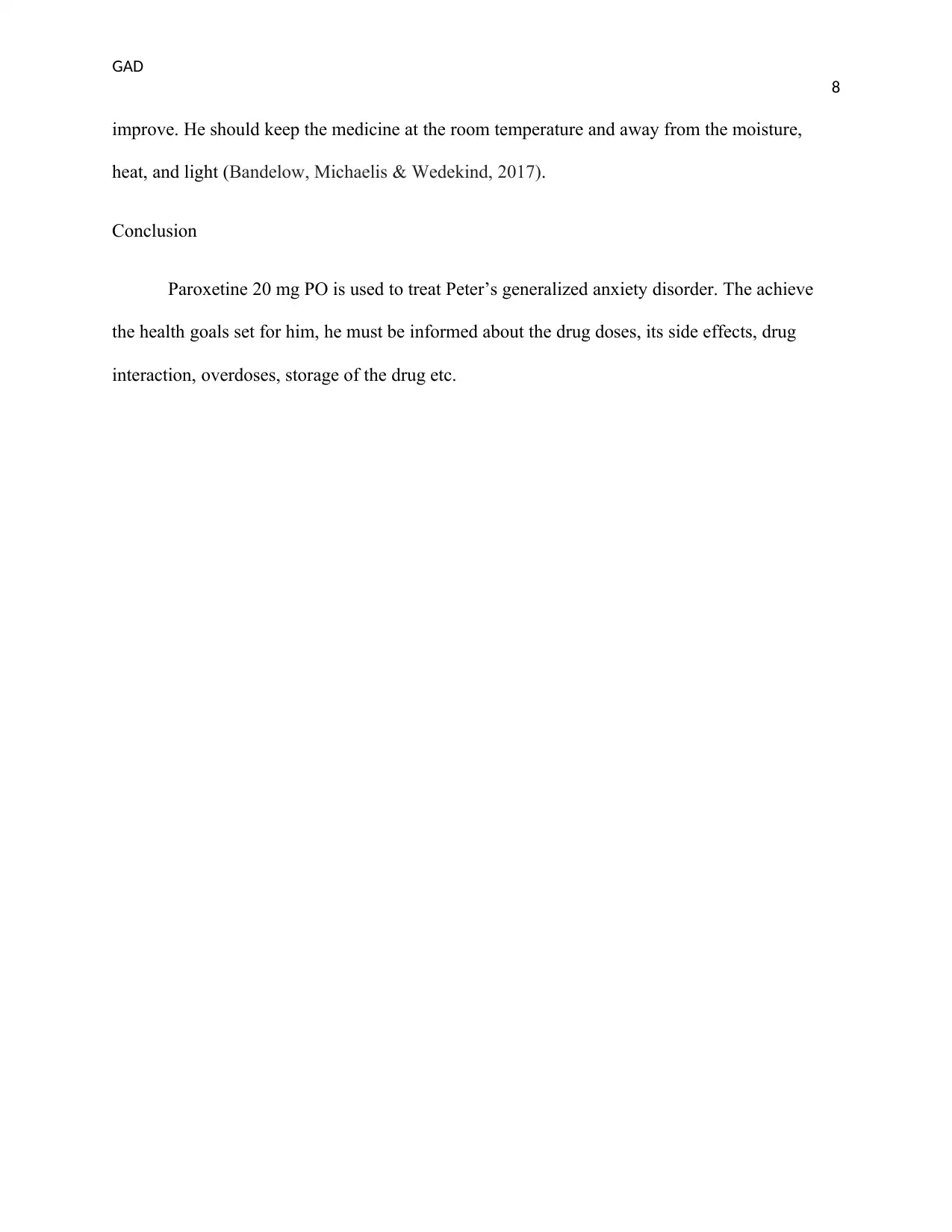
GAD
8
improve. He should keep the medicine at the room temperature and away from the moisture,
heat, and light (Bandelow, Michaelis & Wedekind, 2017).
Conclusion
Paroxetine 20 mg PO is used to treat Peter’s generalized anxiety disorder. The achieve
the health goals set for him, he must be informed about the drug doses, its side effects, drug
interaction, overdoses, storage of the drug etc.
8
improve. He should keep the medicine at the room temperature and away from the moisture,
heat, and light (Bandelow, Michaelis & Wedekind, 2017).
Conclusion
Paroxetine 20 mg PO is used to treat Peter’s generalized anxiety disorder. The achieve
the health goals set for him, he must be informed about the drug doses, its side effects, drug
interaction, overdoses, storage of the drug etc.
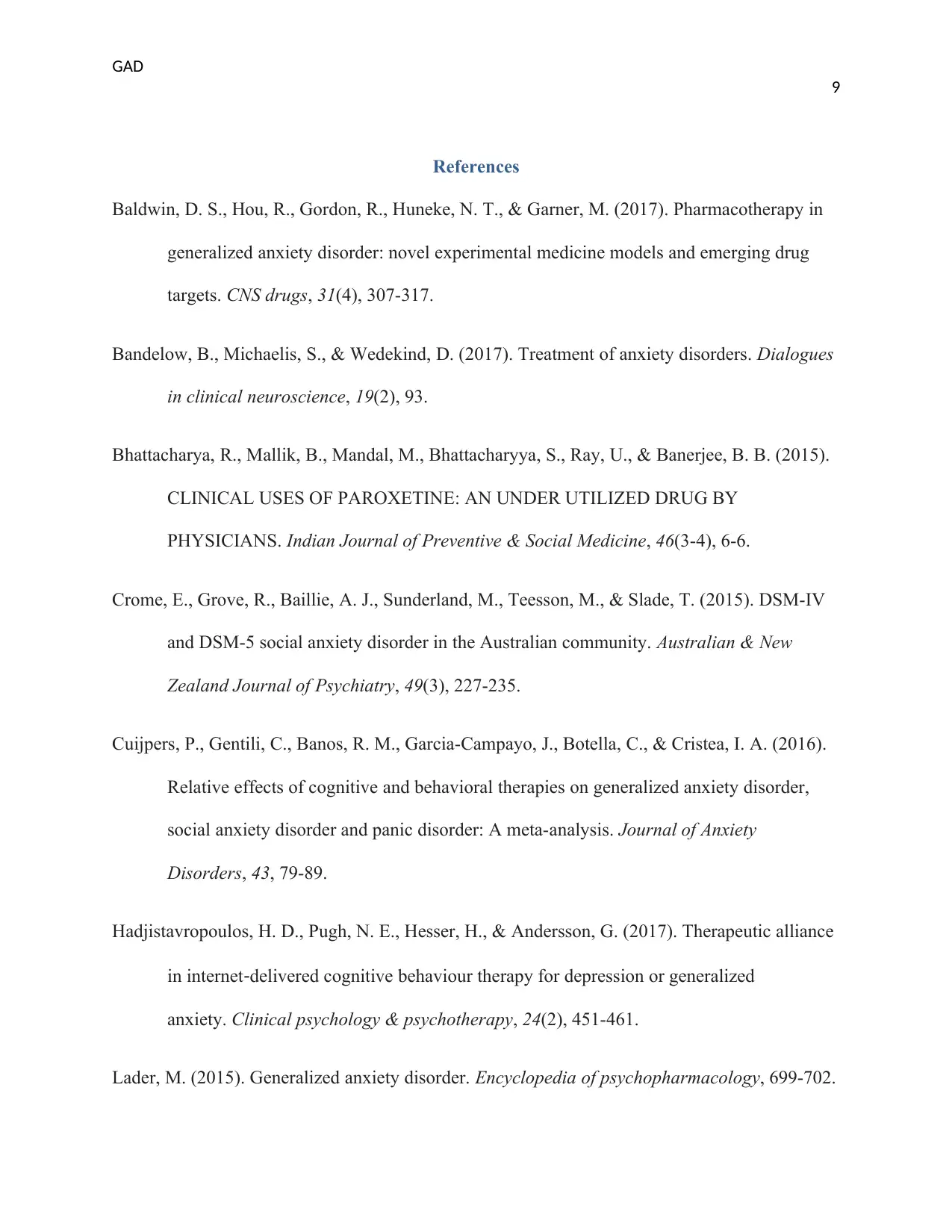
GAD
9
References
Baldwin, D. S., Hou, R., Gordon, R., Huneke, N. T., & Garner, M. (2017). Pharmacotherapy in
generalized anxiety disorder: novel experimental medicine models and emerging drug
targets. CNS drugs, 31(4), 307-317.
Bandelow, B., Michaelis, S., & Wedekind, D. (2017). Treatment of anxiety disorders. Dialogues
in clinical neuroscience, 19(2), 93.
Bhattacharya, R., Mallik, B., Mandal, M., Bhattacharyya, S., Ray, U., & Banerjee, B. B. (2015).
CLINICAL USES OF PAROXETINE: AN UNDER UTILIZED DRUG BY
PHYSICIANS. Indian Journal of Preventive & Social Medicine, 46(3-4), 6-6.
Crome, E., Grove, R., Baillie, A. J., Sunderland, M., Teesson, M., & Slade, T. (2015). DSM-IV
and DSM-5 social anxiety disorder in the Australian community. Australian & New
Zealand Journal of Psychiatry, 49(3), 227-235.
Cuijpers, P., Gentili, C., Banos, R. M., Garcia-Campayo, J., Botella, C., & Cristea, I. A. (2016).
Relative effects of cognitive and behavioral therapies on generalized anxiety disorder,
social anxiety disorder and panic disorder: A meta-analysis. Journal of Anxiety
Disorders, 43, 79-89.
Hadjistavropoulos, H. D., Pugh, N. E., Hesser, H., & Andersson, G. (2017). Therapeutic alliance
in internet‐delivered cognitive behaviour therapy for depression or generalized
anxiety. Clinical psychology & psychotherapy, 24(2), 451-461.
Lader, M. (2015). Generalized anxiety disorder. Encyclopedia of psychopharmacology, 699-702.
9
References
Baldwin, D. S., Hou, R., Gordon, R., Huneke, N. T., & Garner, M. (2017). Pharmacotherapy in
generalized anxiety disorder: novel experimental medicine models and emerging drug
targets. CNS drugs, 31(4), 307-317.
Bandelow, B., Michaelis, S., & Wedekind, D. (2017). Treatment of anxiety disorders. Dialogues
in clinical neuroscience, 19(2), 93.
Bhattacharya, R., Mallik, B., Mandal, M., Bhattacharyya, S., Ray, U., & Banerjee, B. B. (2015).
CLINICAL USES OF PAROXETINE: AN UNDER UTILIZED DRUG BY
PHYSICIANS. Indian Journal of Preventive & Social Medicine, 46(3-4), 6-6.
Crome, E., Grove, R., Baillie, A. J., Sunderland, M., Teesson, M., & Slade, T. (2015). DSM-IV
and DSM-5 social anxiety disorder in the Australian community. Australian & New
Zealand Journal of Psychiatry, 49(3), 227-235.
Cuijpers, P., Gentili, C., Banos, R. M., Garcia-Campayo, J., Botella, C., & Cristea, I. A. (2016).
Relative effects of cognitive and behavioral therapies on generalized anxiety disorder,
social anxiety disorder and panic disorder: A meta-analysis. Journal of Anxiety
Disorders, 43, 79-89.
Hadjistavropoulos, H. D., Pugh, N. E., Hesser, H., & Andersson, G. (2017). Therapeutic alliance
in internet‐delivered cognitive behaviour therapy for depression or generalized
anxiety. Clinical psychology & psychotherapy, 24(2), 451-461.
Lader, M. (2015). Generalized anxiety disorder. Encyclopedia of psychopharmacology, 699-702.
Secure Best Marks with AI Grader
Need help grading? Try our AI Grader for instant feedback on your assignments.
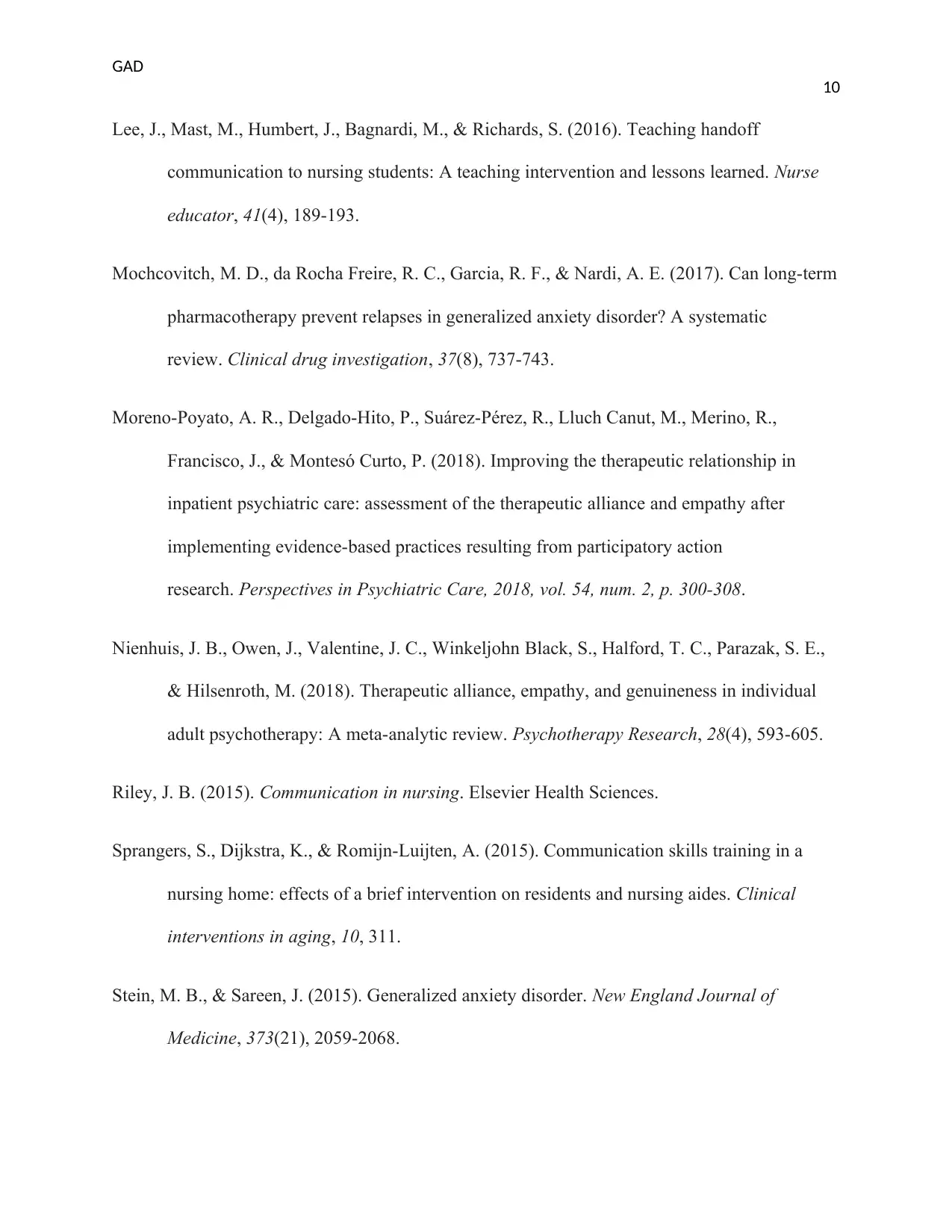
GAD
10
Lee, J., Mast, M., Humbert, J., Bagnardi, M., & Richards, S. (2016). Teaching handoff
communication to nursing students: A teaching intervention and lessons learned. Nurse
educator, 41(4), 189-193.
Mochcovitch, M. D., da Rocha Freire, R. C., Garcia, R. F., & Nardi, A. E. (2017). Can long-term
pharmacotherapy prevent relapses in generalized anxiety disorder? A systematic
review. Clinical drug investigation, 37(8), 737-743.
Moreno-Poyato, A. R., Delgado-Hito, P., Suárez-Pérez, R., Lluch Canut, M., Merino, R.,
Francisco, J., & Montesó Curto, P. (2018). Improving the therapeutic relationship in
inpatient psychiatric care: assessment of the therapeutic alliance and empathy after
implementing evidence-based practices resulting from participatory action
research. Perspectives in Psychiatric Care, 2018, vol. 54, num. 2, p. 300-308.
Nienhuis, J. B., Owen, J., Valentine, J. C., Winkeljohn Black, S., Halford, T. C., Parazak, S. E.,
& Hilsenroth, M. (2018). Therapeutic alliance, empathy, and genuineness in individual
adult psychotherapy: A meta-analytic review. Psychotherapy Research, 28(4), 593-605.
Riley, J. B. (2015). Communication in nursing. Elsevier Health Sciences.
Sprangers, S., Dijkstra, K., & Romijn-Luijten, A. (2015). Communication skills training in a
nursing home: effects of a brief intervention on residents and nursing aides. Clinical
interventions in aging, 10, 311.
Stein, M. B., & Sareen, J. (2015). Generalized anxiety disorder. New England Journal of
Medicine, 373(21), 2059-2068.
10
Lee, J., Mast, M., Humbert, J., Bagnardi, M., & Richards, S. (2016). Teaching handoff
communication to nursing students: A teaching intervention and lessons learned. Nurse
educator, 41(4), 189-193.
Mochcovitch, M. D., da Rocha Freire, R. C., Garcia, R. F., & Nardi, A. E. (2017). Can long-term
pharmacotherapy prevent relapses in generalized anxiety disorder? A systematic
review. Clinical drug investigation, 37(8), 737-743.
Moreno-Poyato, A. R., Delgado-Hito, P., Suárez-Pérez, R., Lluch Canut, M., Merino, R.,
Francisco, J., & Montesó Curto, P. (2018). Improving the therapeutic relationship in
inpatient psychiatric care: assessment of the therapeutic alliance and empathy after
implementing evidence-based practices resulting from participatory action
research. Perspectives in Psychiatric Care, 2018, vol. 54, num. 2, p. 300-308.
Nienhuis, J. B., Owen, J., Valentine, J. C., Winkeljohn Black, S., Halford, T. C., Parazak, S. E.,
& Hilsenroth, M. (2018). Therapeutic alliance, empathy, and genuineness in individual
adult psychotherapy: A meta-analytic review. Psychotherapy Research, 28(4), 593-605.
Riley, J. B. (2015). Communication in nursing. Elsevier Health Sciences.
Sprangers, S., Dijkstra, K., & Romijn-Luijten, A. (2015). Communication skills training in a
nursing home: effects of a brief intervention on residents and nursing aides. Clinical
interventions in aging, 10, 311.
Stein, M. B., & Sareen, J. (2015). Generalized anxiety disorder. New England Journal of
Medicine, 373(21), 2059-2068.

GAD
11
Wilson, B. J., & Ray, D. (2018). Child‐centered play therapy: Aggression, empathy, and self‐
regulation. Journal of Counseling & Development, 96(4), 399-409.
11
Wilson, B. J., & Ray, D. (2018). Child‐centered play therapy: Aggression, empathy, and self‐
regulation. Journal of Counseling & Development, 96(4), 399-409.
1 out of 12
Related Documents
Your All-in-One AI-Powered Toolkit for Academic Success.
+13062052269
info@desklib.com
Available 24*7 on WhatsApp / Email
![[object Object]](/_next/static/media/star-bottom.7253800d.svg)
Unlock your academic potential
© 2024 | Zucol Services PVT LTD | All rights reserved.





